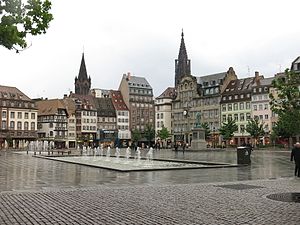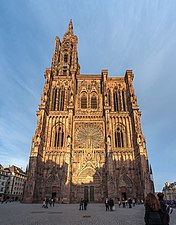Strasbourg: from the Grande-Île to the new town, a European urban scene
| Strasbourg: from the Grande-Île to the new town, a European urban scene | |
|---|---|
|
UNESCO world heritage |
|

|
|
| National territory: |
|
| Type: | Culture |
| Criteria : | (ii) (iv) |
| Surface: | 183 ha |
| Buffer zone: | 708 ha |
| Reference No .: | 495 |
| UNESCO region : | Europe and North America |
| History of enrollment | |
| Enrollment: | 1988 (session 12) |
| Extension: | 2017 |
Strasbourg: from the Grande-Île to the new town, a European urban scene is a UNESCO- listed site of the world cultural heritage in the city of Strasbourg in France . In 1988 only the medieval old town on the Grande Île was entered on the World Heritage List, in 2017 the site was expanded to include the new town from the late 19th century.
background
Strasbourg lies on the left bank of the Upper Rhine . The city goes on in the year 12 BC. Roman military camp called Argentoratum , founded in BC . In the 4th century it became a bishopric . In the Middle Ages , the city belonged to the Holy Roman Empire as a Free Imperial City ; in 1681 it was occupied by France, which saw the Rhine as its natural border. After the Franco-German War was Strasbourg in 1871 as capital of the Empire State Alsace-Lorraine part of the newly founded German Empire until 1919 after the First World War in the Treaty of Versailles was awarded France again.
The location in the border area between the German (Germanic) and French (Romanic) language and cultural areas and the repeated change between the two powers has shaped the development of the cityscape of Strasbourg over centuries.
registration
Strasbourg - Grande île was registered as a cultural heritage site in the list of UNESCO World Heritage Sites in 1988 based on a resolution of the 12th session of the World Heritage Committee. The entry was made on the basis of criteria (i), (ii) and (iv). In summary it says:
Surrounded by two arms of the Ill river, the Grande Île (Big Island) is the historic center of the Alsatian capital. It contains an outstanding complex of architectural monuments in a fairly small area. Far from being isolated monuments, the cathedral, the four old churches and the Palais Rohan, the former residence of the prince-bishops, form a district that is characteristic of a medieval city and the development of Strasbourg from the 15th to the 18th centuries. Century illustrates.
At the 41st meeting in 2017, the world heritage site was expanded to include the new town of Strasbourg and the title of Strasbourg: from the Grande-Île to the new town, a European urban scene was changed. In summary it says:
The new town is based in part on the Haussmannian model in terms of urban design and adopts an architectural language of Germanic inspiration. This double influence has made it possible to create an urban space specific to Strasbourg, in which the angles created around the cathedral open up into a unified landscape around the rivers and canals.
The extended site is registered according to criteria (ii) and (iv).
(ii): French and Germanic influences shaped the Grande-Île and the Neustadt. They have made it possible for both cultures to develop a unique way of expression, which is particularly expressed in the fields of architecture and urban planning. The cathedral, influenced by the Romanesque art of the East and the Gothic art of the Kingdom of France, is also inspired by Prague, particularly for the construction of the tower. It is a model that acted as a transmitter of Gothic art to the east. The Neustadt, a modern city shaped by Haussmannian influences and a model of urban planning, also embodies the theories of Camillo Sitte.
(iv): The Grande-Île and the Neustadt in Strasbourg form a characteristic example of a European Rhineland city. In a way that respects the old original fabric, integrated into a medieval urban fabric, the private residences built between the 15th and late 17th centuries in the Renaissance style form a unique ensemble of Rhenish house architecture that cannot be separated from the outstanding Gothic cathedral. In the 18th century, French classical architecture dominated, as exemplified in the Palais Rohan, which was built by Robert de Cotte, the king's architect. From 1871 onwards, the face of the city was profoundly changed by the establishment of an ambitious urban development project, which led to the emergence of a modern, functional city that became symbolic of the technical progress and hygienic politics that took place at the turn of the 19th and 20th centuries came up. The urban ensemble's private and public buildings are evidence of political, social and cultural change, while the status of the city shifted from a free city of the Holy Roman Empire to a free city of the Kingdom of France before becoming the regional capital.
scope
The World Heritage Site essentially comprises two areas in the city center of Strasbourg , the Grande-Île ( location , protection area 94 ha without buffer zone) and the new town ( location , protection area 89 ha, buffer zone 708 ha).
Grande-Île
Grande-Île (Big Island) is the old town of Strasbourg. It is located on an island between two arms of the river Ill , from which it gets its name. The island is about 1.25 km long and up to 750 m wide. On the island are the Kléberplatz with the classicist former main guardhouse Aubette , the Gothic Strasbourg Cathedral , the cathedral of the Archdiocese of Strasbourg , and four other medieval churches. The city palaces on the island, known as hôtel particulier , include the Palais Rohan , the Hôtel de Hanau (the city's town hall since 1805), the Hôtel des Deux-Ponts and the Archbishop's Palace .
Neustadt
Strasbourg's Neustadt was built in the 19th century when Strasbourg was under German administration. It connects to the north-east of the Grande-Île and is connected to it by bridges. The main axis is the avenue de la Liberté from the Place de la République with the Palais du Rhin (former imperial palace), the National Theater (former state parliament building) and the national and university library to the Place de l'Université with the university palace . The predominant architectural style is historicism , later buildings are also built in the Art Nouveau style . Next to the main axis stands the neo-Gothic Paulskirche at the tip of a river island .
literature
- Strasbourg, Grande-Île . In: The World Heritage . Frederking & Thaler, Munich 2015, ISBN 978-3-95416-181-2 , pp. 334 .
- Strasbourg: Grande-Île of Strasbourg . In: The UNESCO World Heritage . Kunth Verlag, Munich 2017, ISBN 978-3-95504-413-8 , pp. 80 .
Web links
- Strasbourg: from the Grande-Île to the New Town, a European urban scene on the UNESCO World Heritage Center website ( English and French ).
- Grande-Île and Neustadt on www.de.strasbourg.eu
Individual evidence
- ↑ Original name in English Strasbourg: from Grande-île to Neustadt, a European urban scene , French Strasbourg: de la Grande-île à la Neustadt, une scène urbaine européenne , German name according to the World Heritage List. In: www.unesco.de. German UNESCO Commission, accessed on July 11, 2017 .
- ^ A b c Strasbourg: from Grande-île to Neustadt, a European urban scene. In: whc.unesco.org. UNESCO World Heritage Center, accessed July 11, 2017 .
- ↑ Decision: CONF 001 XIV.A. In: whc.unesco.org. UNESCO World Heritage Center, accessed July 11, 2017 .
- ↑ a b Strasbourg - Grande île ( Memento from June 12, 2016 in the Internet Archive )










